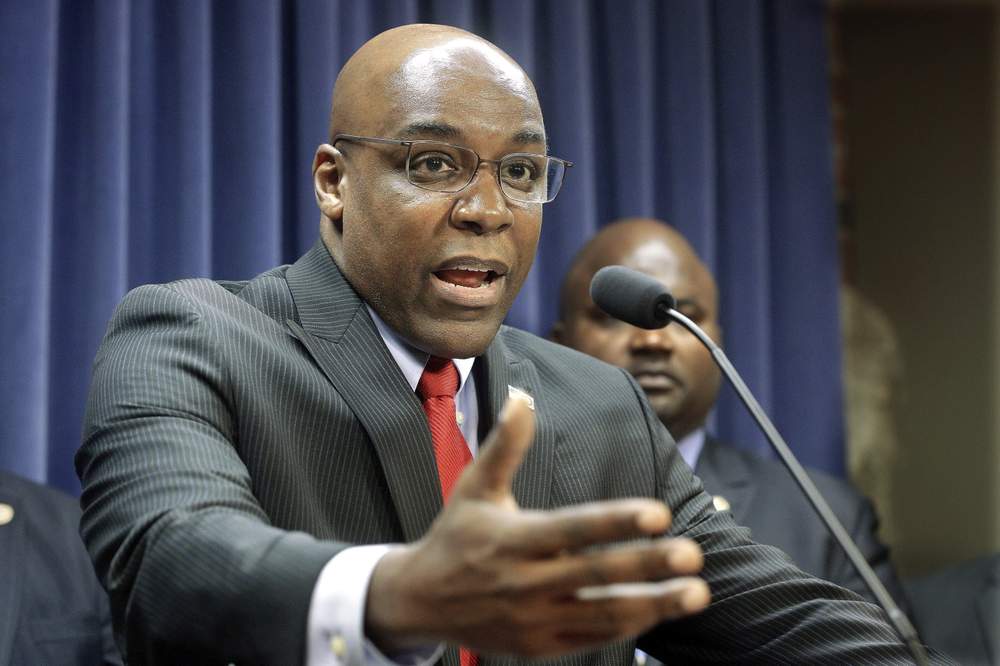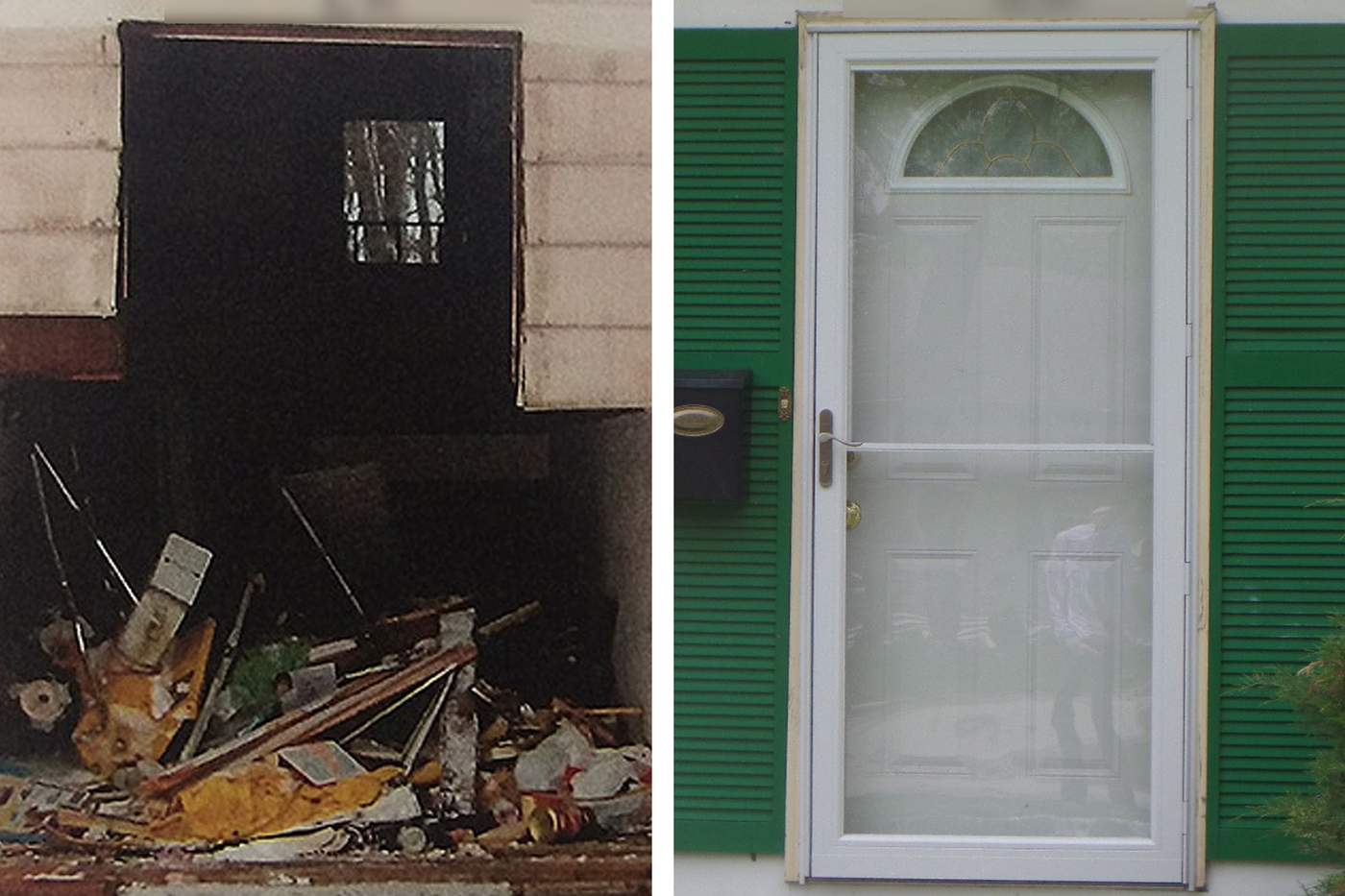In south suburban Robbins, 13-year-old Jakeem Booker was standing in the front doorway of his aunt’s house when he was mistakenly shot in the back with a stray bullet from the gun of a village police officer who was aiming for a fleeing tire rim thief.
Farther south in Glenwood, a belligerent retiree named Robert Lyons was killed by a police sniper’s bullet following an eight-hour standoff in which he pleaded 32 times for the SWAT team surrounding his house to leave. Instead, they used an armored truck to blow through his front door and clear the sniper’s line of sight.
Across Cook County in Evanston, a scuffle between three officers and 32-year-old Desrick York, armed with a switchblade knife, ended in a flurry of police bullets that took York’s life as well as the left ring finger of one of the officers, Adam Nawotka.
Booker, Lyons — and even officer Nawotka — are among dozens of people shot under questionable circumstances by suburban police in Cook County, where officers often make life-or-death decisions under sometimes lax and often unenforced policies regarding the use of deadly force, a Better Government Association/WBEZ investigation has found.
This story is part of a joint project of WBEZ and the Better Government Association. See the stories here.
They have shot at fleeing and unarmed suspects, wounded innocent bystanders and even fellow officers caught in a crossfire. They have fired from, and at, moving vehicles during high speed chases, ramped up confrontations with the mentally ill and tampered with evidence, the investigation found.
Still, in 113 police shootings in the Cook County suburbs since 2005, records show not a single case led to disciplinary action for an officer who made a mistake. Not one lost their job. Not one criminal case was filed against an officer.
Many of these cases will be detailed in this four-part series that offers a vivid portrait of a lack of oversight, remediation, or even self-reflection in some of these cash-strapped community police departments, even as they deal with some of the same big-city problems that grab national headlines just down the road in Chicago.
Chicago and other major cities have come under intense scrutiny for controversial shootings, sparking protests and accusations of institutional racism, codes of silence and leadership that condones brutality and misdeeds in the ranks.
But questionable policing isn’t just a big city problem. Many of the same police practices that stir headlines in urban centers play out in suburbs as well, in particular those with concentrations of low-income and minority residents. Yet such shootings have received far less attention.
Loading...
“I think it’s terrible,” said Cook County Commissioner Richard Boykin, an Oak Park Democrat. “Obviously to not have — in the 113 shootings — not a single incident where officers were disciplined, is highly concerning for me because I know that those are not 113 shooting incidents that were legitimate.
“What it does is further erode the trust between the community and the police,” Boykin said. “Especially if the community feels like somehow there is no accountability for police officers who are just shooting people without having consequences.”
Most of the police shootings reviewed for this report appeared to be justified. Police officers thrust into extraordinarily dangerous circumstances shot and killed criminals who threatened innocent lives while committing armed robberies, domestic violence, carjacking and murder.
At the same time, the BGA/WBEZ examination found at least 42 police shootings that raise reasonable questions about police actions or decisions. These reports — which included dozens of interviews with police experts, shooting victims and witnesses, along with a review of thousands of pages of police records, lawsuits and witness statements — found the insular culture of police protecting themselves stretches well beyond the Chicago city limits.
They will detail how few suburban police departments review their own shootings for policy or procedural violations, and how authority over investigating police for potential criminal violations rests with the state police.
The investigation also reveals how several of those state police investigations were stymied when the suburban officers involved refused to be interviewed about what happened. It also shows how officers are sometimes sent back to the street with a sidearm and a badge despite histories of trouble and abuse both on and off the job, and how suburban taxpayers have quietly doled out more than $12 million to settle lawsuits in at least 25 separate police shootings.
Police critics blame institutional racism and a police bunker mentality for the lack of punishment or remediation in these shooting cases, as well as other high-profile cases in Chicago and throughout the nation.
Suburban police chiefs and their supporters disagree. Many say their officers are patrolling streets in dangerous, poverty-stricken communities and decry a rush to judgment against those required to make split-second decisions under incredible stress.
“If you ask any chief, it’s very rare that they’ll say that ‘I have enough officers,’” said Robert Collins Jr., the police chief of south suburban Dolton where there have been nine police shootings since 2005. “For the level of activity that we see here, we don’t have enough officers. And when you hire officers, it takes money to do that. Unfortunately, sometimes there’s not a lot of money to hire what you need, you have to make do with what you have.”
Stray bullet hits innocent kid
Jakeem Booker was playing video games on March 23, 2008 when he heard his aunt, Kathy Bean, screaming about a commotion in the street outside their Robbins home. With the typical curiosity of a 13-year-old, he went to the front door and saw a fight break out over what he later learned was a stolen car rim, he said in a recent interview.
As he watched, Booker saw police arrive and confront the factions. One of the Robbins officers, Tim Pennington, spotted a man pointing a gun at a crowd of people and ordered him to drop it, police reports later said.
The man, who was never apprehended or identified, started to run and Pennington fired at him three times with his .45-caliber service weapon but missed, the reports said.
One of the those bullets, however, struck Booker in the lower back, and he crumpled to the ground, reports said.
“When I fell, I got up, I tried to run,” said Booker, now 23. “I couldn’t run because the bullet hit my hip. I started to hop. I didn’t know what happened, I was young, I didn’t know what was going on. I just knew I fell and I was trying to get out of the way.”
Booker was the youngest victim shot by police in the suburbs since 2005, one of 12 under the age of 18, the BGA/WBEZ examination found.
Loading...
His broken hip kept him out of junior high school for six weeks, and the bullet still remains lodged within a half-inch of his spine. According to Booker, doctors said it was too risky to remove.
“I didn’t see no gun,” said Kathy Bean, Booker’s aunt, who witnessed the shooting. “He’s still shooting wildly, he could have hit me, he could have hit my daughter. He could have hit anybody. He hit an innocent kid.”
Pennington, now 54, retired from the Robbins Police Department in 2014 after a 23-year career in law enforcement. Earlier in his career, when he worked as an officer with the Chicago Housing Authority, Pennington was suspended for three days in 1994 after what records described as a “profane encounter” with a subordinate officer.
Records indicate Pennington was neither investigated internally nor punished for shooting Booker in the back. Pennington could not be reached for comment.
When he retired, Pennington was earning $10 per hour as a part-time Robbins police officer, underscoring a lack of resources in a village where the median income is about $30,000. Most officers in Robbins are part time and make around $10.50 an hour, in line with a typical fast-food job.
The Village of Robbins settled Booker’s lawsuit for $65,000 in 2011.
“I’m just thankful I’m still here,” said Booker, who is now in the U.S. Navy.
Booker’s case is among six where police accidentally shot unintended targets, the investigation found. In three of those cases, police accidentally shot each other.
Police experts said officers should heed their training and not fire weapons when colleagues or bystanders are in harm’s way, although they acknowledge it is easy to second guess decisions made under high stress.
That’s why departments should review shooting incidents with an eye toward training and preparation, experts said. However, additional training is an unaffordable luxury for some cash-strapped departments.
“Robbins could not simply afford the additional training,” said former Robbins Police Chief Johnny Holmes, who retired in 2013. “You have a lot of officers that would like to go and take additional training on their own and they don’t because they have to pay for it…If they were working for another agency, they could go and that training would be paid for.”
The investigation found little evidence that suburban police agencies do any self-reflection or post-mortem reviews aimed at retraining officers involved in deadly shootings, a practice often employed at larger departments.
In Chicago, there is an independent bureaucracy set up to review policies and procedures called the Chicago Office of Police Accountability. That agency is separate from the department’s own internal affairs division. Even though these efforts have come under harsh criticism at times for appearing to go light on police in shootings, in the suburbs there is no such oversight.
In the suburbs, there are rarely reviews of procedures or policy following officer-involved shootings, record show. The only required oversight in the suburbs comes from the Illinois State Police Public Integrity Task Force.
Under a 2015 state law, an external agency such as the state police task force is required to investigate suburban police shootings. But the scope of such investigations is confined to determining whether an officer committed a crime.
Although the investigation mandate is fairly recent, the task force had been voluntarily reviewing the legality of suburban police shootings for more than a decade. However, its mandate does not extend to investigating policy violations or procedural mistakes.
State Sen. Kwame Raoul, D-Chicago, a lead sponsor of the 2015 legislation and a current candidate for Illinois Attorney General, said he would have preferred the law go further to address systemic problems, but “you have to move the ball forward.”

Illinois State Sen. Kwame Raoul, D-Chicago, speaks during a news conference at the Illinois State Capitol in 2015. (Seth Perlman/AP Photo)
The measure also required the state to begin collecting statistics on all “arrest-related deaths.”
Through interviews, court records and news clips, the investigation by the BGA and WBEZ identified seven suburban police shootings that were not initially acknowledged by the state police or Cook County prosecutors in response to open records requests.
Only after reporters asked state police about the omissions did the agency acknowledge some were left off the list. Among them was the Feb. 24, 2011 shooting death of 67-year-old Robert Lyons in his Glenwood home.
Lyons, a retired businessman, was at home with his wife when a village firefighter named Terry Ooms knocked on the door. Ooms was going house-to-house offering residents free lighted address panels so that emergency crews could more easily find homes at night.
“I don’t need no lighted box,” Lyons snapped at Ooms, according to police reports that portrayed the elderly man as an “anti-government, anti-police survivalist.” His family described him as drunk and scared.
When Ooms then asked Lyons to sign a form refusing the offer, Lyons pulled a handgun and ordered the firefighter to go away.
Ooms ran to his car and called Glenwood police. That triggered an eight-hour standoff that ended in what Frank Murphy, an expert witness in a lawsuit later filed by the family of Lyons, called an outrageous and unnecessary escalation by authorities.
The standoff began after Glenwood Police Chief Demitrous Cook called the South Suburban Emergency Response Team, launching a massive response that even a senior commander on the scene that day recognized as spinning out of control, according to his deposition in the lawsuit.
Tom Fleming, a senior SWAT team official, said in the deposition that he suggested police back away and arrest Lyons later under less threatening circumstances. Fleming said his suggestion for police to “pack up” was ignored.
“I remember Chief Cook saying … ‘I’m worried that if you leave and he comes back out of the house I won’t have the resources to handle it,’” Fleming said in the deposition.
By the time Fleming’s idea was rejected, Lyons’ house was already surrounded by a tactical assault team.
By telephone, Lyons, his wife, Rose, and his daughter all pleaded with authorities to disband the massive police presence, according to records. Police were asked to leave at least 32 times during the standoff, and Lyons promised he wouldn’t “hurt nobody that don’t come in my front door,” according to a police recording of the negotiations between Lyons and police negotiator Jojannye Panczuk.
“Jojannye,” Lyons said during the negotiations. “Do you know how to solve all this problem? You call up on the phone and you get all those frickin’ people out from the front of my house. I mean, seriously, you get them out of the house and then everything is gonna be okay.”
At least nine times police blasted gas canisters into his windows, but Lyons and his wife were wearing gas masks they had stored in his house.
The standoff that began around 2 p.m. finally came to its bloody conclusion around 10:40 p.m., when police drove an armored truck called a BearCat through the front wall of the home.

The South Suburban Emergency Response Team drove a BearCat through the front door of Robert Lyons’ Glenwood home on Feb. 24, 2011. The damage is seen in the image on the left. On the right, an image of the door today. (From court records, Jared Rutecki/BGA)
As the tank-style vehicle plowed on, Lyons fired his shotgun at it before he was killed with a sniper’s bullet.
Murphy, the expert witness, said every action the police took that day fed into Lyons’ paranoid worldview.
“That was part of his deep-seated problem,” said Murphy, a former secret service agent and New Jersey police officer. “That the government was going to kill him, the government was going to come in and take everything he had. And they did, they took everything, they took his life.”
Police found that Lyons’ had booby-trapped his own body with a gun rigged to go off when it was removed from his front pocket, records say.
Cook, the Glenwood police chief, defended the police response in an interview with the BGA.
“The law says you don’t have to retreat or desist from a lawful arrest,” Cook said. “I’m sure it would have played out in a peaceful way if he wouldn’t have pushed it.”
The village of Glenwood settled the lawsuit by paying the Lyons family $249,000.
“It was really hard on a lot of us,” said Joseph Hernandez, 31, Lyons’ grandson, with whom he shared a love of astronomy. “We miss him. He was a big part of our family.”
Finger lost in crossfire
The BGA/WBEZ investigation identified at least 16 suburban shootings where police confronted people behaving erratically and consistent with someone who might be mentally ill or disabled. Five were unarmed.
Experts say police should be trained to take into account someone’s mental status when applying force, if possible. By doing so, officers can potentially step back and realize they don’t necessarily need to use force, according to Michael Schlosser, Police Training Institute director at the University of Illinois at Urbana-Champaign.
“We are thinking to ourselves ‘This is not a criminal situation as much as it is a medical situation,’” said Schlosser, whose academy is among several that provide initial training required for all police officers in Illinois.
The BGA/WBEZ examination also found three shootings in which suburban police accidentally shot each other. Police experts said officers should not be firing weapons when it would endanger other officers.
“If you’re in a situation where it’s a deadly fire type of a situation, you want to make sure you’re not in a crossfire,” said Raymond Cordell, a former director of Suburban Law Enforcement Academy, where many suburban police are trained.
On April 26, 2009, Evanston officers Christopher Tortorello, Anthony Sosa and Adam Nawotka arrived at an apartment building on a report of a man being threatened with a knife.
The three police found 32-year-old Desrick York holding a switchblade knife and standing over the building’s repairman.
York was depressed after six months of unemployment and had been drinking, his family later told investigators. According to police reports, York was angry that repairs to his apartment had been taking too long and he began yelling at the repairman while holding the knife in the basement.
Ignoring police commands to drop the knife, York moved toward the officers and they opened fire, the reports said.
In the flurry of bullets, Nawotka was shot in the hand as he reached to push York away. Reports say the bullet came from Tortorello’s gun.
“My left ring finger was nearly severed from my hand by the gunshot,” Nawotka later reported. He has since been promoted to detective, and messages left for him were not returned. Tortorello declined to be interviewed.
But Evanston Police Chief Richard Eddington said he found no fault in the shooting because of the immediate threat, although the incident spurred the department to arm all of its officers with tasers in addition to guns.
He said no administrative report was compiled regarding the shooting.
“I’m not sure I see the advantage of publicly delving into all these matters,” Eddington said in an interview with the BGA. “I realize the political considerations, but there are corollary issues that have to be dealt with inside the department.
“So I’m not sure that in these situations that every event needs to be publicized versus if there’s something wrong, or a problem, or suspicious,” he said. “It’s going to get all the attention it merits.”
This story is a joint project of WBEZ and the Better Government Association.
Casey Toner and Jared Rutecki are reporters with the Better Government Association. Patrick Smith, a criminal justice reporter with WBEZ, contributed to this report.
How we did this
To compile this report, the Better Government Association and WBEZ examined tens of thousands of pages of documents obtained through the Illinois Freedom of Information Act for every time a police officer fired a gun in a Cook County suburb since January 1, 2005 in which at least one person was wounded.
Among the agencies that provided documents were the Illinois State Police Public Integrity Task Force, which conducts an investigation in every such shooting to determine whether the police officers involved are criminally liable, states attorney’s offices, medical examiners and municipal police departments. In addition, the BGA and WBEZ analyzed lawsuit files, arrest records, police use-of-force policies and officer disciplinary records for each of the officers involved.
The result is the first-ever comprehensive and searchable database of suburban Cook County police shootings that provides details of the officers involved and demographic information for those who were shot.
From these documents — as well as interviews with officers, their supervisors and numerous police experts — profiles of each shooting were developed in order to determine which of the shootings raise questions about training, policies or police decisions.
Because this examination raises questions about a shooting, that does not necessarily mean the shooting was unjustified. It simply means an examination of the data available suggests the potential exists that policies were not followed, mistakes may have been made, or that police decisions — before, during, or after a shooting — may have contributed in some way to the tragic events that unfolded.
Criminal justice reporting and investigative journalism at WBEZ is supported in part by Doris and Howard Conant and the Robert R. McCormick Foundation.



